The uniform polyhedra are polyhedra consisting of regular (possibly polygrammic) faces of equal edge length whose polyhedron vertices are all symmetrically equivalent. The uniform polyhedra include the Platonic solids (consisting of equal convex regular polygon faces), Archimedean soldis (consisting of convex regular faces of more than one type). Unlike these special cases, the uniform polyhedra need not enclose a volume and in general have self-intersections between faces. For example, the Kepler-Poinsot polyhedra (consisting of equal concave regular polygon or polygram faces) are uniform polyhedra whose outer hulls enclose a volume but which contain interior faces corresponding to parts of the faces that are not part of the hull. Badoureau discovered 37 such nonconvex uniform polyhedra in the late nineteenth century, many previously unknown (Wenninger 1983, p. 55).
Coxeter et al. (1954) conjectured that there are 75 uniform polyhedra in which only two faces are allowed to meet at an polyhedron edge, and this surmise was subsequently proven. The five pentagonal prisms can also be considered uniform polyhedra, bringing the total to 80. In addition, there are two other polyhedra in which four faces meet at an edge, the great complex icosidodecahedron and small complex icosidodecahedron (both of which are compounds of two uniform polyhedra).
The polyhedron vertices of a uniform polyhedron all lie on a circumsphere whose center is their geometric centroid (Coxeter et al. 1954, Coxeter 1973, p. 44). The polyhedron vertices joined to another polyhedron vertex lie on a circle (Coxeter et al. 1954).
Not-necessarily circumscriptable versions of uniform polyhedra with exactified numeric vertices and polygrammic faces sometimes split into separate polygons are implemented
in the Wolfram Language as UniformPolyhedron["name"]
or UniformPolyhedron["Uniform", n
] (cf. Garcia 2019). The full exact, equilateral,
circumscriptable uniform polyhedra are implemented in the Wolfram
Language as PolyhedronData["name"]
or PolyhedronData[
"Uniform", n
].
Except for a single non-Wythoffian case, uniform polyhedra can be generated by Wythoff's kaleidoscopic method of construction. In this construction, an initial vertex inside
a special spherical triangle is mapped to all the other vertices by repeated reflections
across the three planar sides of this triangle. Similarly,
and its kaleidoscopic images must cover the sphere an integral
number of times which is referred to as the density
of
. The density
is dependent on the choice of angles
,
,
at
,
,
respectively, where
,
,
are reduced rational numbers greater than one. Such a spherical
triangle is called a Schwarz triangle, conveniently
denoted
.
Except for the infinite dihedral family of
for
, 3, 4, ..., there are only 44 kinds of Schwarz triangles
(Coxeter et al. 1954, Coxeter 1973). It has been shown that the numerators
of
,
,
are limited to 2, 3, 4, 5 (4 and 5 cannot occur together) and so the nine choices
for rational numbers are: 2, 3, 3/2, 4, 4/3, 5, 5/2, 5/3, 5/4 (Messer 2002).
The names of the 75 uniform polyhedra were first formalized in Wenninger (1983, first printed in 1971), based on a list prepared by N. Johnson a few years earlier, as slightly modified by D. Luke. Johnson also suggested a few modifications in the original nomenclature to incorporate some additional thoughts, as well as to undo some of Luke's less felicitous changes. The "List of polyhedra and dual models" in Wenninger (1983) gives revised names for several of the uniform polyhedra. The names of the five pentagonal prisms appeared in Har'El (1993).
The following table gives the names of the uniform polyhedra and their duals as given in Wenninger (1983) and Har'El (1993) and with the numberings of Maeder (1997), Wenninger
(1971), Coxeter et al. (1954), and Har'El (1993). Coxeter et al. (1954)
give many properties of the uniform solids, and Coxeter et al. (1954), Johnson
(2000), and Messer (2002) give the quartic equation for determining the central angle
subtending half an edge. The single non-Wythoffian case is the great
dirhombicosidodecahedron with Maeder index 75 which has pseudo-Wythoff
symbol .
|
|
|
|
|
|
|
|
|
|
|
|
|
|
|
|
|
|
|
|
|
|
|
|
|
|
|
|
|
|
|
|
|
|
|
|
|
|
|
|
|
|
|
|
|
|
|
|
|
|
|
|
|
|
|
|
|
|
|
|
|
|
|
|
|
|
|
|
|
|
|
|
|
|
|
|
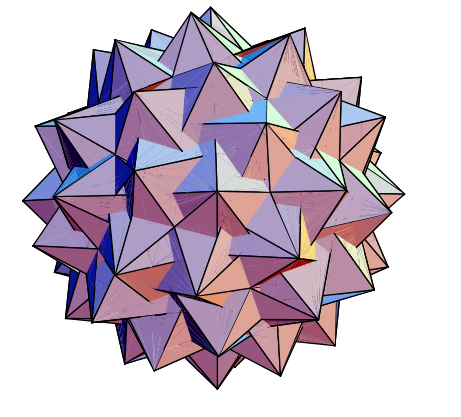
|
|
|
|
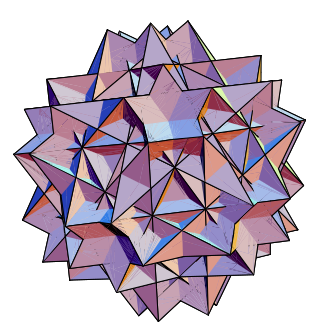
|
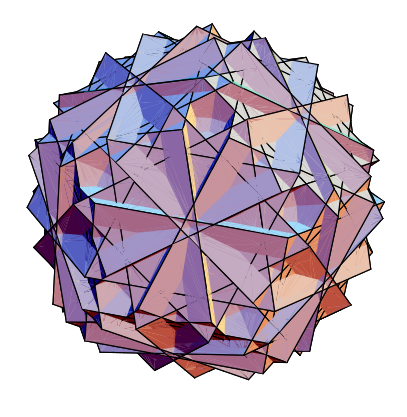
|
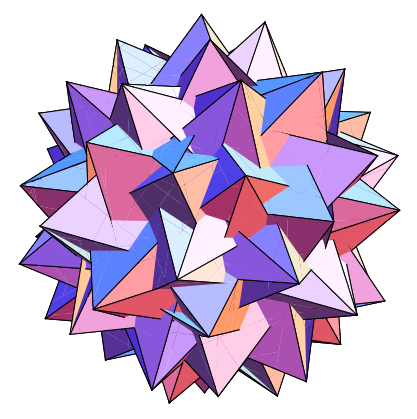
|
|
|
|
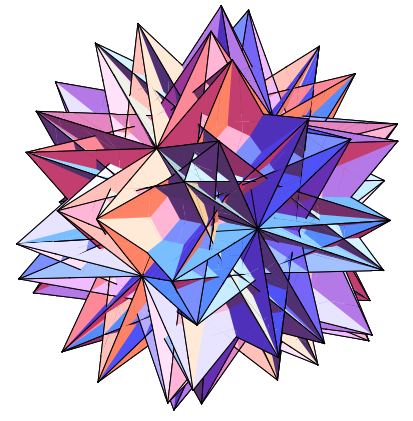
|
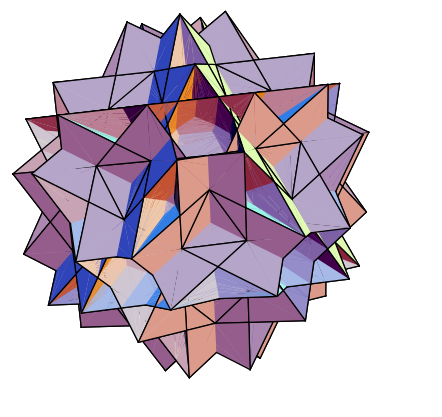
|
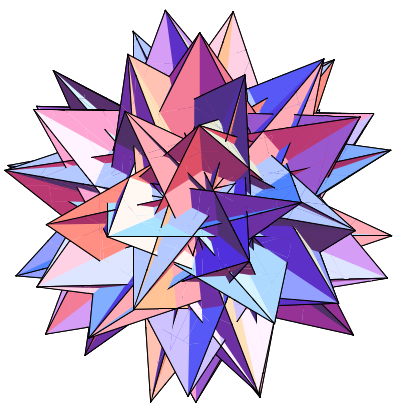
|
|
|
|
|
|
|
|
Johnson (2000) proposed a further revision of the "official" names of the uniform polyhedra and their duals and, at the same time, devised a literal symbol for each uniform polyhedron. For each uniform polyhedron, Johnson (2000) gives its number in Wenninger (1989), a modified Schläfli symbol (following Coxeter), a literal symbol, and its new designated name. Not every uniform polyhedron has a dual that is free from anomalies like coincident vertices or faces extending to infinity. For those that do, Johnson gives the name of the dual polyhedron. In Johnson's new system, the uniform polyhedra are classified as follows:
1. Regular (regular polygonal vertex figures),
2. Quasi-regular (rectangular or ditrigonal vertex figures),
3. Versi-regular (orthodiagonal vertex figures),
4. Truncated regular (isosceles triangular vertex figures),
5. Quasi-quasi-regular (trapezoidal vertex figures),
6. Versi-quasi-regular (dipteroidal vertex figures),
7. Truncated quasi-regular (scalene triangular vertex figures),
8. Snub quasi-regular (pentagonal, hexagonal, or octagonal vertex figures),
9. Prisms (truncated hosohedra),
10. Antiprisms and crossed antiprisms (snub dihedra)
Here is a brief description of Johnson's symbols for the uniform polyhedra (Johnson). The star operator
appended to "D" or "E" replaces pentagons
by pentagrams
. The bar operator
indicates the removal from a related figure of a set (or sets)
of faces, leaving "holes" so that a different set of faces takes their
place. Thus, C
O
is obtained from the cuboctahedron CO by replacing the eight triangles by four hexagons.
In like manner, rR'
CO
has the twelve squares of the rhombicuboctahedron rCO and the six octagons of the
small cubicuboctahedron R'CO but has holes in place of their six squares and eight
triangles. The operator "r" stands for "rectified": a polyhedron
is truncated to the midpoints of the edges. Operators "a", "b",
and "c" in the Schläfli symbols
for the ditrigonary (i.e., having ditrigonal vertex figures) polyhedra stand for
"altered," "blended," and "converted." The operator
"o" stands for "ossified" (after S. L. van Oss). Operators
"s" and "t" stand for "simiated" (snub) and "truncated."
Primes and capital letters are used for certain operators analogous to those just mentioned. For instance, rXY is the "rhombi-XY," with the faces of the quasi-regular XY supplemented by a set of square "rhombical" faces. The isomorphic r'XY has a crossed vertex figure. The operators "R" and "R'" denote a supplementary set of faces of a different kind--hexagons, octagons or octagrams, decagons or decagrams. Likewise, the operators "T" and "S" indicate the presence of faces other than, or in addition to, those produced by the simpler operators "t" and "s." The vertex figure of s'XY, the "vertisnub XY," is a crossed polygon, and that of s*XY, the "retrosnub XY," has density 2 relative to its circumcenter.
Regular polyhedra:
| 1 | T | tetrahedron | tetrahedron | |
| 2 | O | octahedron | cube | |
| 3 | C | cube | octahedron | |
| 4 | I | icosahedron | dodecahedron | |
| 5 | D | dodecahedron | icosahedron | |
| 20 | D* | small stellated dodecahedron | great dodecahedron | |
| 21 | E | great dodecahedron | small stellated dodecahedron | |
| 22 | E* | great stellated dodecahedron | great icosahedron | |
| 41 | J | great icosahedron | great stellated dodecahedron |
Quasi-regular polyhedra:
| 11 | r | CO | cuboctahedron | rhombic dodecahedron |
| 12 | r | ID | icosidodecahedron | rhombic triacontahedron |
| 73 | r | ED* | dodecadodecahedron | middle rhombic triacontahedron |
| 94 | r | JE* | great icosidodecahedron | great rhombic triacontahedron |
| 70 | a | ID* | small ditrigonary icosidodecahedron | small triambic icosahedron |
| 80 | b | DE* | ditrigonary dodecadodecahedron | middle triambic icosahedron |
| 87 | c | JE | great ditrigonary icosidodecahedron | great triambic icosahedron |
Versi-regular polyhedra:
| 67 | o | T | tetrahemihexahedron | no dual |
| 78 | o | C | cubohemioctahedron | no dual |
| 68 | o | O | octahemioctahedron | no dual |
| 91 | o | D | small dodecahemidodecahedron | no dual |
| 89 | o | I | small icosahemidodecahedron | no dual |
| 102 | o | E | small dodecahemiicosahedron | no dual |
| 100 | o | D* | great dodecahemiicosahedron | no dual |
| 106 | o | J | great icosahemidodecahedron | no dual |
| 107 | o | E* | great dodecahemidodecahedron | no dual |
Truncated regular polyhedra:
| 6 | t | tT | truncated tetrahedron | triakis tetrahedron |
| 7 | t | tO | truncated octahedron | tetrakis hexahedron |
| 8 | t | tC | truncated cube | triakis octahedron |
| 92 | t' | t'C | stellatruncated cube | great triakis octahedron |
| 9 | t | tI | truncated icosahedron | pentakis dodecahedron |
| 10 | t | tD | truncated dodecahedron | triakis icosahedron |
| 97 | t' | t'D* | small stellatruncated dodecahedron | great pentakis dodecahedron |
| 75 | t | tE | great truncated dodecahedron | small stellapentakis dodecahedron |
| 104 | t' | t'E* | great stellatruncated dodecahedron | great triakis icosahedron |
| 95 | t | tJ | great truncated icosahedron | great stellapentakis dodecahedron |
Quasi-quasi-regular polyhedra: and
| 13 | rr | rCO | rhombicuboctahedron | strombic disdodecahedron |
| 69 | R'r | R'CO | small cubicuboctahedron | small sagittal disdodecahedron |
| 77 | Rr | RCO | great cubicuboctahedron | great strombic disdodecahedron |
| 85 | r'r | r'CO | great rhombicuboctahedron | great sagittal disdodecahedron |
| 14 | rr | rID | rhombicosidodecahedron | strombic hexecontahedron |
| 72 | R'r | R'ID | small dodekicosidodecahedron | small sagittal hexecontahedron |
| 71 | ra | rID* | small icosified icosidodecahedron | small strombic trisicosahedron |
| 82 | R'a | R'ID* | small dodekified icosidodecahedron | small sagittal trisicosahedron |
| 76 | rr | rED* | rhombidodecadodecahedron | middle strombic trisicosahedron |
| 83 | R'r | R'ED* | icosified dodecadodecahedron | middle sagittal trisicosahedron |
| 81 | Rc | RJE | great dodekified icosidodecahedron | great strombic trisicosahedron |
| 88 | r'c | r'JE | great icosified icosidodecahedron | great sagittal trisicosahedron |
| 99 | Rr | RJE* | great dodekicosidodecahedron | great strombic hexecontahedron |
| 105 | r'r | r'JE* | great rhombicosidodecahedron | great sagittal hexecontahedron |
Versi-quasi-regular polyhedra:
| 86 | or | rR' | small rhombicube | small dipteral disdodecahedron |
| 103 | Or | Rr' | great rhombicube | great dipteral disdodecahedron |
| 74 | or | rR' | small rhombidodecahedron | small dipteral hexecontahedron |
| 90 | oa | rR' | small dodekicosahedron | small dipteral trisicosahedron |
| 96 | or | rR' | rhombicosahedron | middle dipteral trisicosahedron |
| 101 | Oc | Rr' | great dodekicosahedron | great dipteral trisicosahedron |
| 109 | Or | Rr' | great rhombidodecahedron | great dipteral hexecontahedron |
Truncated quasi-regular polyhedra:
| 15 | tr | tCO | truncated cuboctahedron | disdyakis dodecahedron |
| 93 | t'r | t'CO | stellatruncated cuboctahedron | great disdyakis dodecahedron |
| 79 | Tr | TCO | cubitruncated cuboctahedron | trisdyakis octahedron |
| 16 | tr | tID | truncated icosidodecahedron | disdyakis triacontahedron |
| 98 | t'r | t'ED* | stellatruncated dodecadodecahedron | middle disdyakis triacontahedron |
| 84 | T'r | T'ED* | icositruncated dodecadodecahedron | trisdyakis icosahedron |
| 108 | t'r | t'JE* | stellatruncated icosidodecahedron | great disdyakis triacontahedron |
Snub quasi-regular polyhedra: or
| 17 | sr | sCO | snub cuboctahedron | petaloidal disdodecahedron |
| 18 | sr | sID | snub icosidodecahedron | petaloidal hexecontahedron |
| 110 | sa | sID* | snub disicosidodecahedron | no dual |
| 118 | s*a | s*ID* | retrosnub disicosidodecahedron | no dual |
| 111 | sr | sED* | snub dodecadodecahedron | petaloidal trisicosahedron |
| 114 | s'r | s'ED* | vertisnub dodecadodecahedron | vertipetaloidal trisicosahedron |
| 112 | S'r | S'ED* | snub icosidodecadodecahedron | hexaloidal trisicosahedron |
| 113 | sr | sJE* | great snub icosidodecahedron | great petaloidal hexecontahedron |
| 116 | s'r | s'JE* | great vertisnub icosidodecahedron | great vertipetaloidal hexecontahedron |
| 117 | s*r | s*JE* | great retrosnub icosidodecahedron | great retropetaloidal hexecontahedron |
Snub quasi-regular polyhedron:
| 119 | SSr | SSJE* | great disnub disicosidisdodecahedron | no dual |
Prisms:
| P(p) | |||
| P(p/d) |
Antiprisms and crossed antiprisms:
| s | Q(p) | ||
| s | Q(p/d) | ||
| s' | Q'(p/d) |